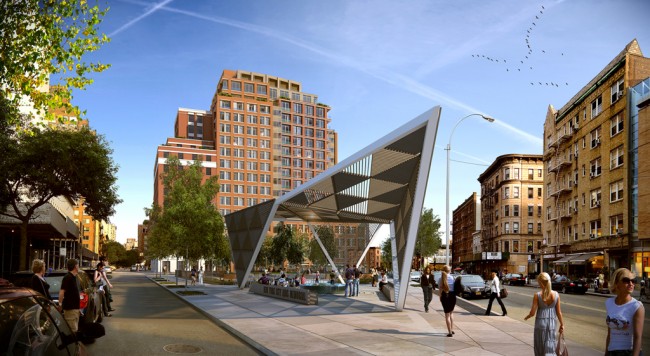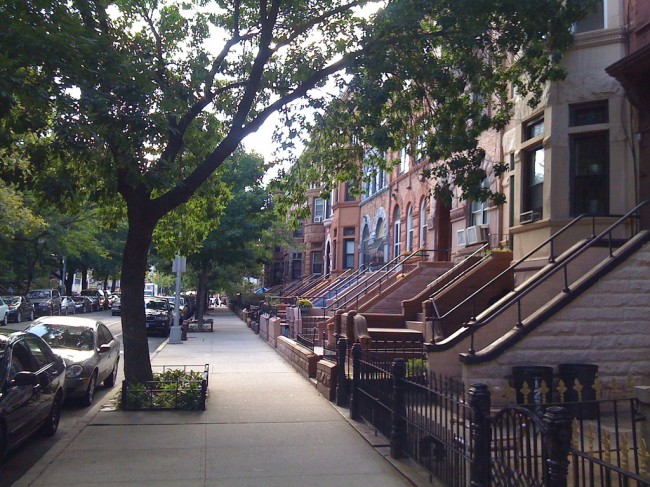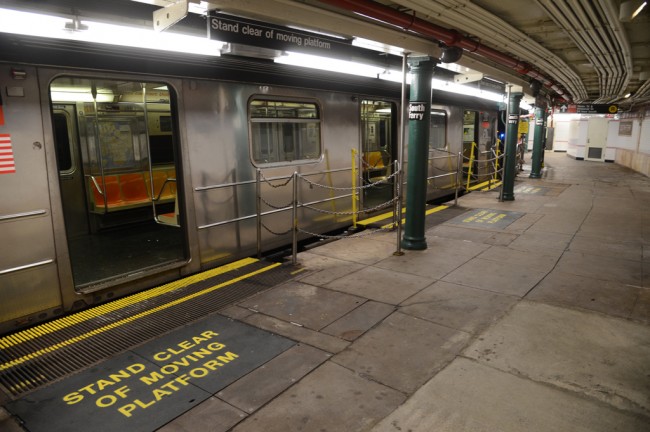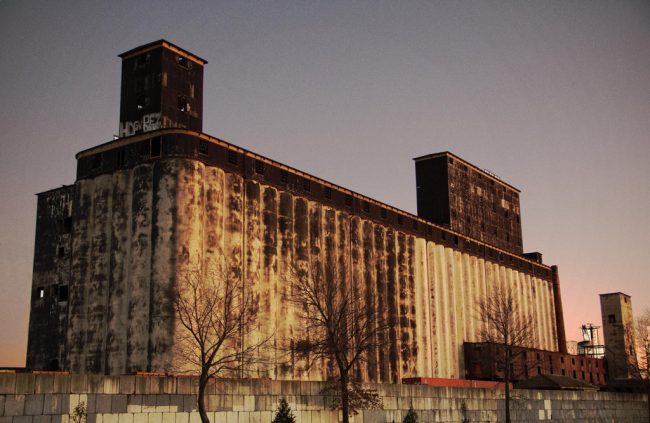
We are celebrating 15 years — and counting — of stories that are deeply researched and deeply felt, that build a historical record of what the city has been.
We are celebrating 15 years — and counting — of stories that are deeply researched and deeply felt, that build a historical record of what the city has been.

The NYC AIDS Memorial by Studio a+1 | Image via New York City AIDS Memorial
NYC AIDS MEMORIAL
The final design for the New York City AIDS Memorial, to be constructed next to the former St. Vincent’s Hospital, one of the first in the nation to offer HIV treatment, was released this week. The site plan, conceived by Brooklyn-based Studio a+1, calls for a steel canopy opening to the new St. Vincent’s Hospital Park, which will feature a fountain and benches surrounded by paving engraved with texts to memorialize New Yorkers struck by the disease and the caregivers and activists who sought to confront the AIDS epidemic.
CLOSED DATA
New York City under Mayor Bloomberg has touted its commitment to making its immense data sources open to the public in an effort to spur new ideas and efficiency. The New York World reports that, in stark contrast to this movement, the City’s Department of City Planning (DCP) continues to charge up to $1,500 for use of its MapPLUTO tool, a compilation of data from various city agencies on all the city’s tax parcels that is prized by developers, planners, and community groups alike. DCP claims that since it has collected the data from different agencies that distribute the information for free, they do not have to do so as well, and that their maps are protected under copyright. Critics point to the Open Data Law, which requires all public data to be downloadable for free online by 2018. Non-profit group 596 Acres avoided the fees by utilizing another law meant to provide the public with access to government records and information: through a Freedom of Information Law request, they obtained the complete map of the five boroughs (price: $1500) for the five-dollar cost of the CD-ROMs the maps came on.

Crown Heights Historic District in Brooklyn, approved in 2011 | Image via Jon Keegan
BLOOMBERG THE PRESERVATIONIST
Under Mayor Bloomberg, more sites across the five boroughs have been landmarked than under any other previous mayor since the establishment of the Landmarks Preservation Commission in 1965, reports the Wall Street Journal. Much of this expansion has come in the form of historic districts, with 41 added or extended in Bloomberg’s three-term stint so far and more in the works. While some observers see the preservation push as a necessary and notable counterweight to the Mayor’s pro-development bent, critics of the expansion see landmarking under Bloomberg as more of a planning tool used to guide development rather than a mechanism for preserving architecture of cultural importance.
BLANK SLATE IN THE BRONX and MORE MICRO-UNITS
NYC’s Department of Housing Preservation and Development (HPD) issued a Request for Proposals (RFP) this week to develop two of the largest empty lots in the South Bronx. While the sites — which sit across the street from the celebrated Via Verde development near the Hub in Melrose — must contain affordable housing, HPD is otherwise looking to developers for their own ideas for what should rise on the site, potentially including community and commercial space. Meanwhile, on the heels of January’s adAPT NYC micro-unit housing competition results, HPD also announced yesterday that they expect to issue two to three additional RFPs for micro-unit developments later this year following a review of City-owned sites.
ILLUSTRATED NEW YORK
New York’s buildings have long been the inspiration and subject of artistic output. James Gulliver Hancock, an Australian illustrator, is now in the third year of a quest to draw (almost) all of them. Some of his drawings can be found at All the Buildings in New York or in the recently released book compiling 500 distinct structures across the boroughs.

The old South Ferry station, with ample gap fillers due to its tight curve, reopened Thursday | Image via MTA
SANDY UPDATES
With many New Yorkers displaced by Sandy still struggling to find permanent housing solutions that they can afford, FEMA and the federal Department of Housing and Urban Development announced that they will utilize the Disaster Housing Assistance Program launched following Hurricane Katrina to directly pay landlords rent for eligible families that would otherwise go homeless. The goal of the program is to move residents out of temporary housing solutions put to use following the storm, such as hotels and short-term rentals.
Staten Island Ferry riders and straphangers coming to and from the southern tip of Manhattan can once again use the South Ferry subway station. The renovated station — newly opened in 2009 after a $500 million upgrade — was inundated by the storm surge during Sandy and will take an estimated three years to restore to full working order. In the meantime, the old part of the station has received a $2 million sprucing up, including a new entrance, lighting, and monitors, to return it to passenger service.
EVENTS and STUFF TO DO
ARTBRIDGE: ANOTHER NEW YORK
ArtBridge, which mounts installations to transform scaffolding into temporary art exhibits, invites Brooklyn-based photographers to submit small series of works that capture New York City with a new and different eye in a time of “derivative street photography and Instagram reaching limitless heights.” Selected works will be displayed on the construction fence and scaffolding of the Atlantic Yards development beginning in July. Submissions are due Sunday, April 14th.
COLLABORATIVE CITIES
Brooklyn interdisciplinary art center The Invisible Dog will screen the premiere of the Collaborative Cities web series on Wednesday, April 10th. The series, which seeks to examine how people share resources, skills, facilities, and experiences, features 12 short films culled from over 40 interviews with participants in increasingly prevalent collaborative programs such as coworking facilities, food co-ops, and carpooling services. Register here to attend.
BIKE THE BRANCHES
If you enjoy bikes and books, join the Brooklyn Public Library for Bike the Branches, a one-day choose-your-own-adventure bike ride to as many of its 60 branches as you like, each hosting entertainment and activities throughout the day, or along routes charting Brooklyn’s literary, culinary, and architectural history. Registration is now open for the May 11th event.

The New York Grain Terminal at the Gowanus Bay Terminal, the staging ground for Enemy of the People | Image via Michael Tapp
ENEMY OF THE PEOPLE
Falconworks Artists Group will present Henrik Ibsen’s Enemy of the People, a play relating a Norwegian town’s grappling with toxic runoff in its local water supply, a stone’s throw from the Superfund-designated Gowanus Canal at the Gowanus Bay Terminal. The play, which runs from May 2nd through 5th, has been tweaked to fit the neighborhood’s own toxic waterway and the EPA’s proposal for its cleanup. Purchase tickets to one of five performances here.
MAPPING MANHATTAN
Becky Cooper, a writer and cartographer, will discuss her book Mapping Manhattan: A Love (and Sometimes Hate) Story in Maps by 75 New Yorkers alongside New Yorker staff writer Adam Gopnik and other map contributors on April 29th at 92Y Tribeca. The book is the outgrowth of Cooper’s project to ask people from across Manhattan to create personal maps of the borough.
The Roundup keeps you up to date with topics we’ve featured and other things we think are worth knowing about.
The views expressed here are those of the authors only and do not reflect the position of The Architectural League of New York.